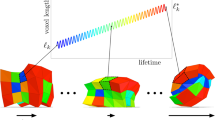Abstract
In psychology the ‘A not B’ error, whereby infants perseverate in reaching to the location where a toy was previously hidden after it has been moved to a new location, has been the subject of fifty years research since it was first identified by Piaget [1]. This paper describes a novel implementation of the ‘A not B’ error paradigm which is used to test the notion that minimal systems evolutionary robotics modelling can be used to explore developmental process and to generate new hypotheses for test in natural experimental populations. The model demonstrates that agents controlled by plastic continuous time recurrent neural networks can perform the ‘A not B’ task and that homeostatic mediation of plasticity can produce perseverative error patterns similar to those observed in human infants. In addition, the model shows a developmental trend for the production of perseverative errors to reduce during development.
Preview
Unable to display preview. Download preview PDF.
Similar content being viewed by others
References
Piaget, J.: The Origins of Intelligence in the Child. Routledge & Kegan Paul, London (1952)
Harvey, I., Di Paolo, E., Wood, R., Quinn, M., Tuci, E.: Evolutionary Robotics: A New Scientific Tool for Studying Cognition. Artificial Life 11(1-2) (2005)
Di Paolo, E.A.: Behavioural Coordination, Structural Congruence and Entrainment in a Simulation of Acoustically Coupled Agents. Adaptive Behaviour 8(1), 27–48 (2000)
Thelen, E., Smith, L.B.: A Dynamic Systems Approach to the Development of Cognition and Action. MIT Press, Cambridge (1994)
Beer, R.: Toward the Evolution of Dynamical Neural Networks for Minimally Cognitive Behaviour. In: Maes, P., Mataric, M., Meyer, J-A., Pollack, J., Wilson, S. (eds.) From Animals to Animats 4: Proceedings of the Fourth International Conference on Simulation of Adaptive Behaviour, MIT Press, Cambridge (1996)
Ashby, W.: Design for a Brain. John Wiley and Sons Inc., Chichester (1960)
Iizuka, H., Di Paolo, E.A.: Toward Spinozist Robotics: Exploring the Minimal Dynamics of Behavioural Preference. Adaptive Behaviour (Accepted)
Tuci, E., Quinn, M., Harvey, I.: Using a Net to Catch a Mate: Evolving CTRNNs for the Dowry Problem. In: From Animals to Animats 7: Proceedings of the Seventh International Conference on Simulation of Adaptive Behaviour, MIT Press, Cambridge (2002)
Thelen, E., Schoener, G., Scheier, C., Smith, L.: The Dynamics of Embodiment: A Dynamic Field Theory of Infant Perseverative Reaching. Behavioural and Brain Sciences 24, 1–86 (2001)
Author information
Authors and Affiliations
Editor information
Rights and permissions
Copyright information
© 2007 Springer-Verlag Berlin Heidelberg
About this paper
Cite this paper
Wood, R., Di Paolo, E. (2007). New Models for Old Questions: Evolutionary Robotics and the ‘A Not B’ Error. In: Almeida e Costa, F., Rocha, L.M., Costa, E., Harvey, I., Coutinho, A. (eds) Advances in Artificial Life. ECAL 2007. Lecture Notes in Computer Science(), vol 4648. Springer, Berlin, Heidelberg. https://doi.org/10.1007/978-3-540-74913-4_114
Download citation
DOI: https://doi.org/10.1007/978-3-540-74913-4_114
Publisher Name: Springer, Berlin, Heidelberg
Print ISBN: 978-3-540-74912-7
Online ISBN: 978-3-540-74913-4
eBook Packages: Computer ScienceComputer Science (R0)




